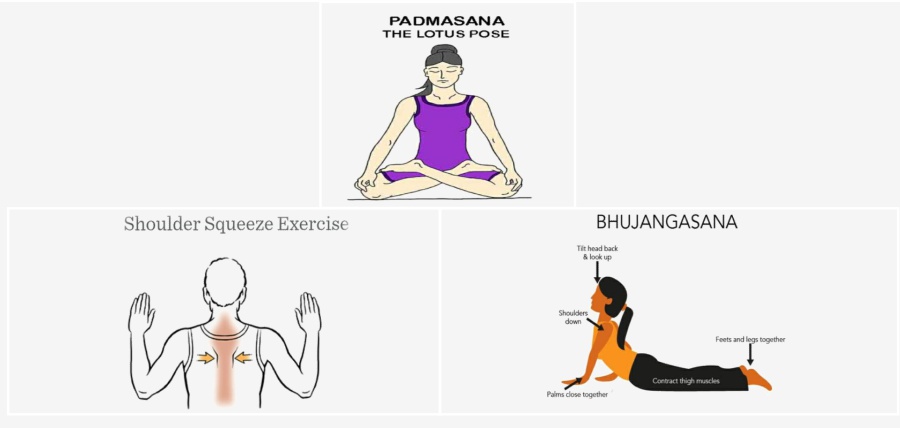Good posture is more than just standing up straight so you can look your best.
It is a key factor regulating your long-term health.
Ensuring that you hold your body the right (optimal) way whether you are still or moving can prevent pain, injuries, and other health problems.
What is posture?
Simply defined, posture is the attitude your body assumes either by co-ordinated action of muscles or by support during the muscle activity to maintain stability.
Orthopaedic literature broadly categorizes static postures into, lying supine (face up), lying prone (face down), sitting, standing, kneeling, hanging. So basically, majority of activities [sleep-eat-work-play-travel-meditation(?!)-repeat] performed during the whole lifetime can be called as extensions of these basic static postures.
Also, while doing activities like walking, running, playing tennis, bending forward to pick up something etc. the way we hold our body, forms an efficient basis for movement. These are called dynamic postures.
Humans, being bipedal, much of natural stress (weight of head, upper body) is already borne by back. So, which ever activity we do, we create an additional stress on back. Hence, the alignment of your back (spine) is of utmost importance during postural evaluation and management.
So, what happens when you assume less-than-optimal (bad) posture? Let’s take an example, WFH. Yes, you heard it right, WORK FROM HOME!! Day in and day out, sitting on your chair (Oh! You have an Ergonomic one?!) In front of your laptop/desktop/tablet/smartphone who has turned the so called ‘couch potatoes’ into ‘chair potatoes with tingling hands and numbed feet!
Let’s have another one, although it can be seen anywhere anytime, it is seen especially in kitchen/garden chores. You bend forward million times while preparing a day’s meals. And, up until one fine, bright, sunny morning when you get that sudden back pain out of nowhere. You wonder what it could be?
It is nothing but the daily (for decades in succession) repetition of incorrect bending posture’s ultimatum to stop it ASAP. Thus, very often back pain may be because of sustained faulty postures, weak muscles supporting the back leading to abnormal stress over joint structures.
Above scenarios are glimpses of very-much-preventable-pain in daily life.
What can be done?
- Postural awareness and actively correcting the posture (can set mini alarms to achieve this)
- Performing exercises like Scapular muscle exercise (shoulder blade squeeze exercise), thoracic and lumbar extension exercise (Bhujangasan), Suryanamaskars, tadasana (the tree pose), padmasana (the lotus pose), abdominal muscle exercise, Pilates etc. daily to achieve and maintain good postural muscle strength and endurance.
- Sleeping on a firm (preferably simple cotton) mattress, to ensure proper rest for a fatigued body. Use a pillow to support neck/head. Preferably lying on your back. (Obviously the zillions of postures we get into once fast asleep are subjective and beyond the scope of discussion here)
- The forever advice of sitting/standing upright (with shoulders back). Don’t be a slouch!
- Want to keep it simple yet effective? Just put some books under laptop so the screen is at your eye level. Keep a pillow behind back in your normal chair. And sit way behind in the chair until your knees are right angle (90 degrees) and feet flat on the floor. Keep a folded napkin under elbow when sitting on a chair with hand support (this ensures supported shoulder posture).

- Taking feasible 2 hour breaks to help neutralize the loads.
- Can do chair yoga/easy stretches/light walk/simply stroll around to refill your water bottle.
- Use knees to squat and reach the object at floor level with relatively straight back.

- Sit down and do floor level activities and then get up. Or else, grab a chair sit on it and then do activities at a lower height. (this is a special tip for household/kitchen/garden chores)
- Use a handy yet sturdy stool to reach heights
- When carrying heavy objects, hold them close to your body, distribute weight in both hands.
- Moving furniture around? Push that table/chair instead of pulling it.

- Wherever possible, adjust the widely used furniture in house/office at a height such that you need not bend forward every time you use it.
Take away notes:
Optimal (good) posture is one in which there is least strain on your back, while allowing you to freely perform movement.
Voluntary correction techniques are MUST.
Following ergonomic (postural) advice and exercises by your Physiotherapist/health care professional on a daily basis helps in prevention of pain and injuries to large extent.
About the author:
Dr Neha Deshpande Manakeshwar, M.P.Th, is a Seasoned Physiotherapy Clinician. She is an alumnus of the prestigious Seth G.S Medical College and K.E.M hospital, Mumbai. She is a University Gold Medalist, internationally published Physiotherapist with more than a decade of successful Clinical practice. Her special interests include Spine, Shoulder, Knee, Women’s health, and Sports rehabilitation. Please note that above article is written for a layman understanding of posture. Any queries are welcome on neha.manakeshwar@gmail.com


